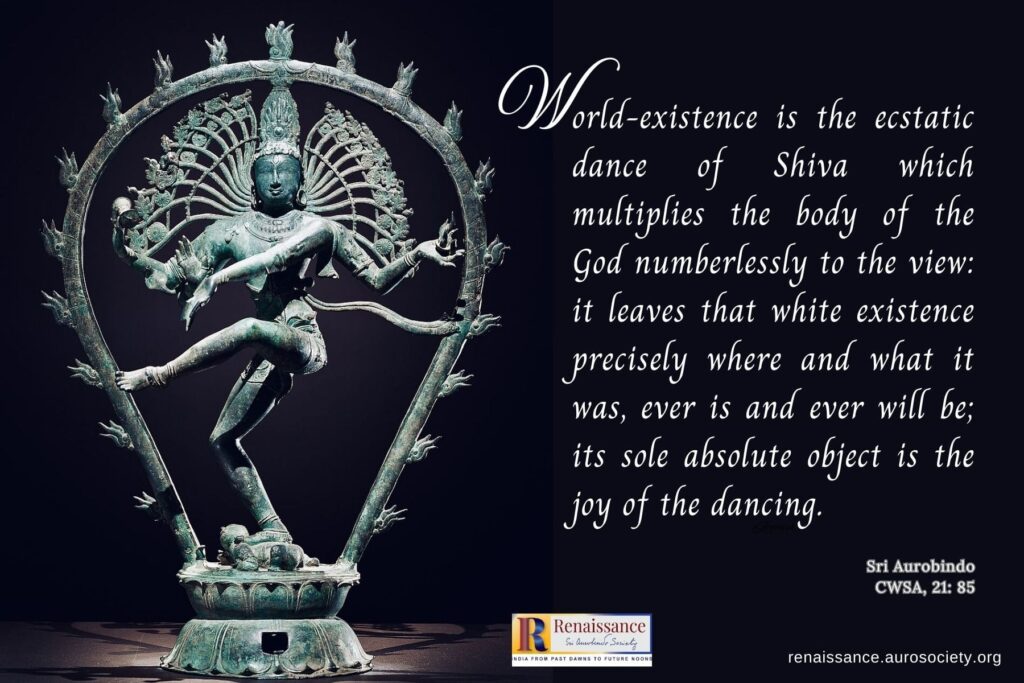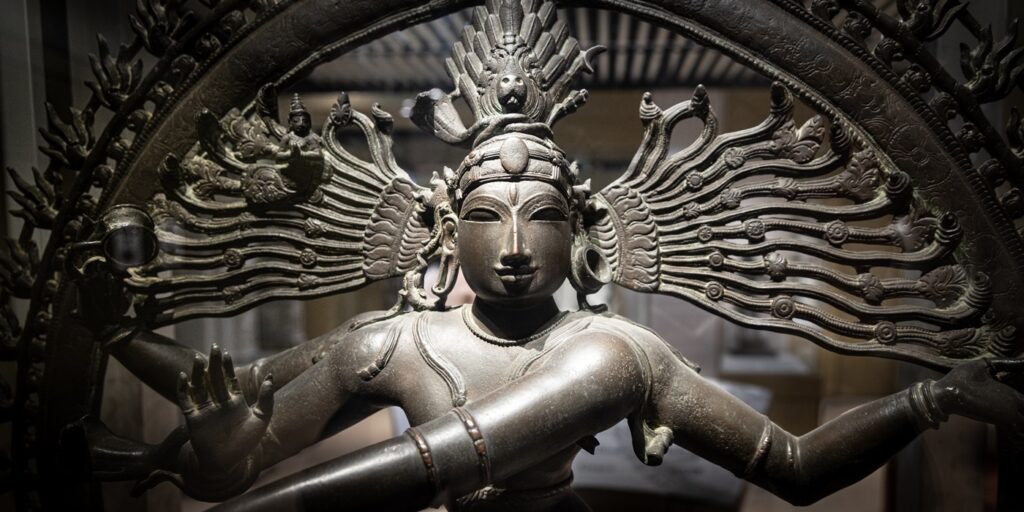Date: April 16, 2025
Part 3: Nataraja, the Cosmic Dancer
Continued from Part 2
Nataraja is an aspect of Shiva. He is the Cosmic Dancer. The word Nataraja literally means the Lord of Dance. In all the religious literatures of the world, we would usually find statements like “God created the universe” or such similar ideas.
The Bible states that God created the world for six continuous days and after the work of creation was finished, he rested on the seventh day. It implies that God is separate from his creation. That creation is his handiwork and he is separate from it. In the same manner that a painter is separate from his painting. The painter and his creation are separate. Or in a way a sculptor and his sculpture are separate. In other words, the creator, after his work of creation is complete, stands apart from it and is no longer a participant in his creation.
But Shiva being depicted as a dancer is very significant. A dancer is always present in his dance. If a dancer pauses his dance even for a moment, the dance exists no more. So, a dancer is never separate from his dance. Nataraja, the Cosmic Dancer symbolizes that this universe is his dance. He is not outside it but through his dance, he sustains the universe. He is ever present in his creation. In other words, Brahman or God is not separate from the world. Brahman is the world. That is why the Isha Upanishad declares: Isha vasyam idam sarvam – the whole universe is enveloped by the Lord. This universe is not an object created by the Lord from which he stands apart. But this universe is his dance in which he is ever present.
Nataraja symbolizes the ultimate reality in the form of a dance of energy in the quantum as well as the existential domain. The Nataraja symbol combines in a single form the tri-fold aspect of Shiva’s roles as Creator, Preserver and Destroyer of the universe. In Shiva’s endless dance movements are expressed the forces of creation, preservation, destruction and in the graceful steps is hidden a deep understanding of our universe.

Exploring the Nataraja Symbolism
Nataraja’s dance is not just a symbol. This cosmic dance is taking place in the microcosm, in the macrocosm and within each one of us, at the atomic level, in every moment.
Shiva or Nataraja holds a drum in his upper right hand. The drum is capable of producing sound. And sound always requires space for its propagation. Sound can exist only in space. And space is the basis of this universe. So, the drum denotes creation or the creative principle.
In his upper left-hand Shiva holds a tongue of flames. This denotes destruction and dissolution of forms. So, creation and destruction in perfect balance. Our minds can think only in terms of dualities. For us creation and destruction are two separate things. We feel that they are antagonistic to each other. But Shiva holding the drum in one hand and a tongue of flames on the other points out that they are inseparable. Creation and destruction are always co-existent and inseparable.
He holds his lower right hand in a gesture of assurance – Abhaya Mudra – which says: Fear not, i.e., protection. This is the principle of preservation. So, these three hands of Nataraja shows that the entire universe is a constant interplay of creation, preservation and destruction.
Then we find that the lower left hand of Nataraja is bent at the wrist and pointing downwards. This is known as the gesture of the elephant – Gajahasta Mudra. That is because the hand assumes the shape of an elephant’s trunk. An elephant’s trunk is capable of performing a heavy work like uprooting a tree or carrying a log. At the same time, it is also capable of performing a fine job like picking up a needle from the ground. In the sphere of the intellect, this means the power of discrimination, which is possible only when one possesses both gross and subtle intellect. With gross intellect we deal with the things of the physical world, with appearances. But with subtle intellect we deal with the things of higher dimension. With subtle intellect we catch hold of the Reality behind the Appearances. A perfected individual has both gross and the subtle intellect at his command. This is denoted by the Gajahasta mudra.
Another interpretation says that the hand is actually pointing to the uplifted left leg. The significance of Nataraja having his left foot raised high above the ground denotes release from the spell of Maya. Shiva is not in Maya – he is free, liberated. The uplifted foot denotes that liberation.
With the right foot we find Nataraja trampling down on a dwarf demon named Apasmara. The word Apasmara indicates loss of memory or consciousness of who we are; a spiritual amnesia about our real nature. Apasmara represents the ignorant, deluded being, Jiva, who is subject to the triple impurities of littleness (anava), desires and attachments (pasa), and delusion (moha) caused by ignorance.
Anava means egoism, smallness, or atomicity. Anu means atom, thus Anava means choosing to be like an atom, when in reality we are the supreme Self. In reality we are limitless, eternal, indestructible, and indivisible. But our ego makes us feel that we are a limited being, distinct and separate from others. Ego is also responsible for our pride, sense of possession and desire-ridden actions. These are the pasa-s, the bonds that tie us down. It is also the state of delusion, where we cannot properly discriminate between truth and falsehood. This self-forgetfulness, this amnesia of our real nature is represented by the dwarf demon Apasmara and Nataraja crushes him under his feet and frees us from Maya represented by the uplifted leg.

Nataraja’s matted hair – Jata – is open and flying. Jata is a symbol for penance, Tapasya. One gets matted hair only when one is totally involved in the inner consciousness and is oblivious to the care and beautification of the physical body. Therefore, where the matted hair means Tapasya – the open and flying locks of hair of Nataraja represent a state that is trans-Tapas. He is in a state of ecstatic dance which is diametrically opposite to the state of inner withdrawal and Tapasya. In his ecstatic dance, he is not withdrawn into himself but rather expressing himself in his exuberant, ecstatic dance of creation, preservation and destruction. Open and flying hair denotes abandon and ecstasy. Because Nataraja revels in his dance.
The entire form of Nataraja is surrounded by a circle of fire known as the Prabha Mandala. Fire is a vivid image of energy and the circle of fire denotes energy. The whole process of creation, existence and destruction is nothing but energy taking various forms. In his book The Dance of Shiva, Ananda Coomaraswamy, the historian and philosopher of Indian art writes,
“He rises from his rapture, and dancing sends through inert matter pulsing waves of awakening sound, and lo! Matter also dances, appearing as a glory round about Him. Dancing, He sustains its manifold phenomena. In the fullness of time, still dancing, He destroys all forms and names by fire and gives new rest. This is poetry, but none the less science.”
The Prabha Mandala is a vivid image of the dance of energy that is taking place not only in the visible, physical world but also in the world of sub-atomic matter. Hence it is not a wonder that a two-meter statue of Nataraja has been installed at the European Organisation of Nuclear Research (CERN) in Geneva, Switzerland which is the world’s largest physics research laboratory.
